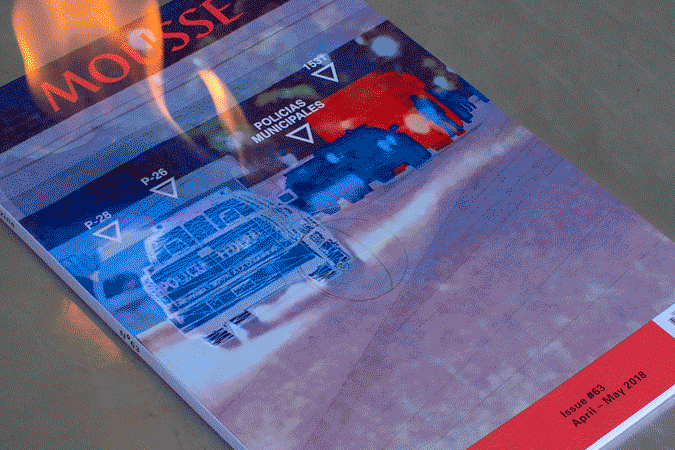Issue #63
April–May 2018
Get issue #63 or subscribe
iPad edition #63 and subscription available soon on Apple Newsstand
In this issue:
Mother Tongue by Rose Vickers
Is there an argument for a treatment of “voice aesthetics” in art?
Four Women: Evelyn Taocheng Wang by Hendrik Folkerts
Evelyn Taocheng Wang speaks about language as an inspiration, as well as about Eileen Chang, Princess Kaguya, Virginia Woolf, and herself.
The Inhabitant and the Map: Forensic Architecture and Metahaven by Richard Birkett
While sharing ground in addressing forms of state and extra-state power, the practices of Metahaven and Forensic Architecture also diverge in fundamental ways.
A Narrow Ladder with Which to Steal Apples: Lisa Ponti by Hans Ulrich Obrist and Franco Toselli
Lisa Ponti retraces her life as editor for Domus magazine; her father, the architect Gio Ponti; her activity as a poet and children’s book writer; and her artistic practice.
Lin May Saeed’s Slow Burn by Chris Sharp
Lin May Saeed has been actively making work for more than fifteen years, but is only just now starting to get broader visibility.
And:
Eva Huttenlauch speaks with Saâdane Afif about his practice, focusing on interpretation, exchange, performance, objects, and texts.
In conversation with Chiara Giovando, Jacqueline Kiyomi Gordon and C. Spencer Yeh discuss sound as a sculptural material.
Andrea Lissoni discloses Pan Daijing’s method, practice, and influences in a WhatsApp conversation scattered between London, Berlin, and Shanghai.
Roxana Marcoci talks to Dominique Gonzalez-Foerster about her Apparitions, part of the M.2062 project of real and imaginary characters.
“One might think our future is open and indeterminate, waiting to be filled with meaning, the result of our creative intention… But that is not true: Our future is being colonized, its potentiality withdrawn, in ways increasingly visible as well as irreversible.” —T. J. Demos on the colonization of the Anthropocene.
Elvia Wilk speaks to Ryan John King and Katya Zavyalova of the “decentralized architecture office” Foam about what blockchain architecture can do for the real world.
In a career that lasted just a decade, Nicolas Moufarrege produced an idiosyncratic body of paintings. Dean Daderko, Élisabeth Lebovici, and Mounira Al Solh acknowledge the artist’s work and the myriad issues surrounding it.
Dieter Roelstraete reveals how two of the twentieth century’s most influential philosophers—Martin Heidegger and Ludwig Wittgenstein—lived in huts on the literal and metaphorical outskirts of society.
Sabrina Tarasoff: “The idea is that in our spooked zeitgeist of art’s post-whatever condition, the transformation of an object to its dancing alter ego often happens via language-based interlocution within what Ann Philbin refers to as the ‘space of mediation.’”
Omar Kholeif, writing on Hayv Kahraman’s explorations of the history of painting, draws correlations between Western portraits of female bodies, Middle Eastern motifs, and Kahraman’s diasporic life.
Natasha Ginwala on Vivan Sundaram’s exhibition Step inside and you are no longer a stranger, a dimly lit room where beds made from iron frames form an eerie meshwork, and low-voltage bulbs illuminate a negative cartography.
Ross Simonini on Ser Brandon-Castro Serpas’s first solo show at Current Projects in Miami, where found objects—a used mattress, an old door, a vacuum cleaner—are arranged like a community of the damned.
Christina Lehnert, Leo Asemota, Nástio Mosquito, Bonaventure Soh Bejeng Ndikung, and Philippe Pirotte are drafting an experimental exhibition at Portikus in the form of a text.
Anastassia Smirnova on Liberté, by Albert Serra, the last part of a trilogy exploring eighteenth-century courtiers.
Marie de Brugerolle’s idea of “post-performance” is a response to the vacuity of the term “performance” when used as a means to distract audiences.
Buy Mousse #63
More reviews, interviews and essays on moussemagazine.it
Join our newsletter
Books by Mousse Publishing
Mousse Agency
Film & video on vdrome.org


